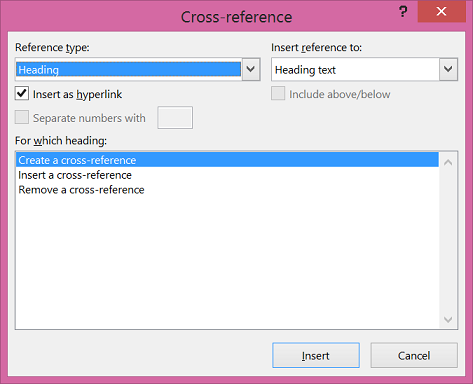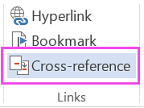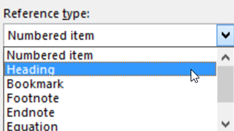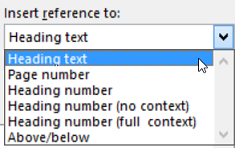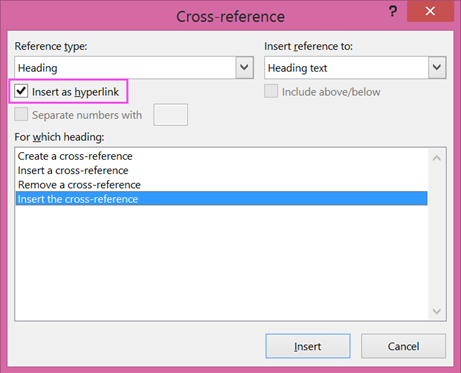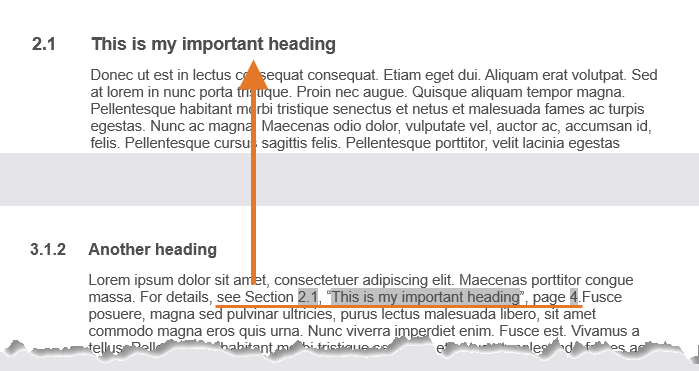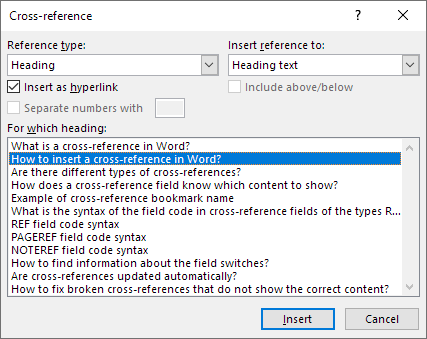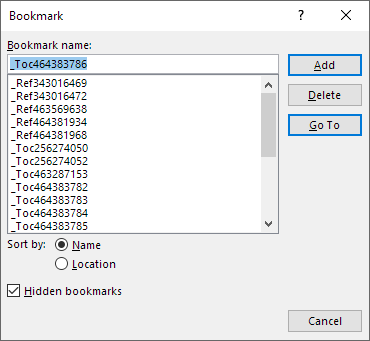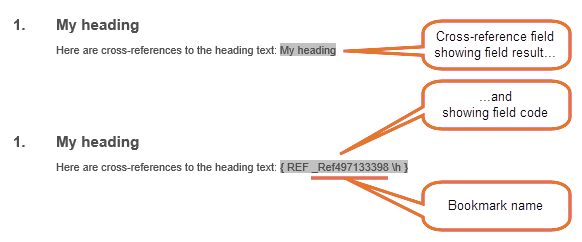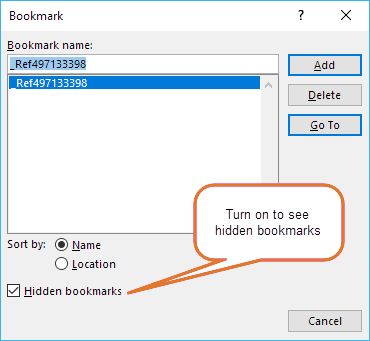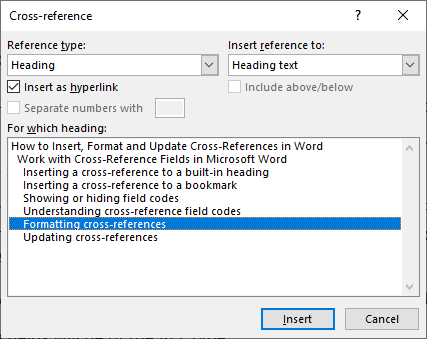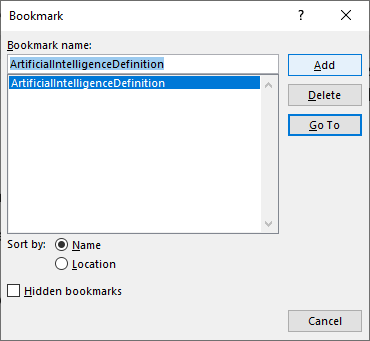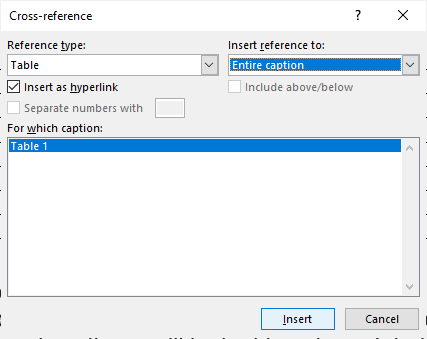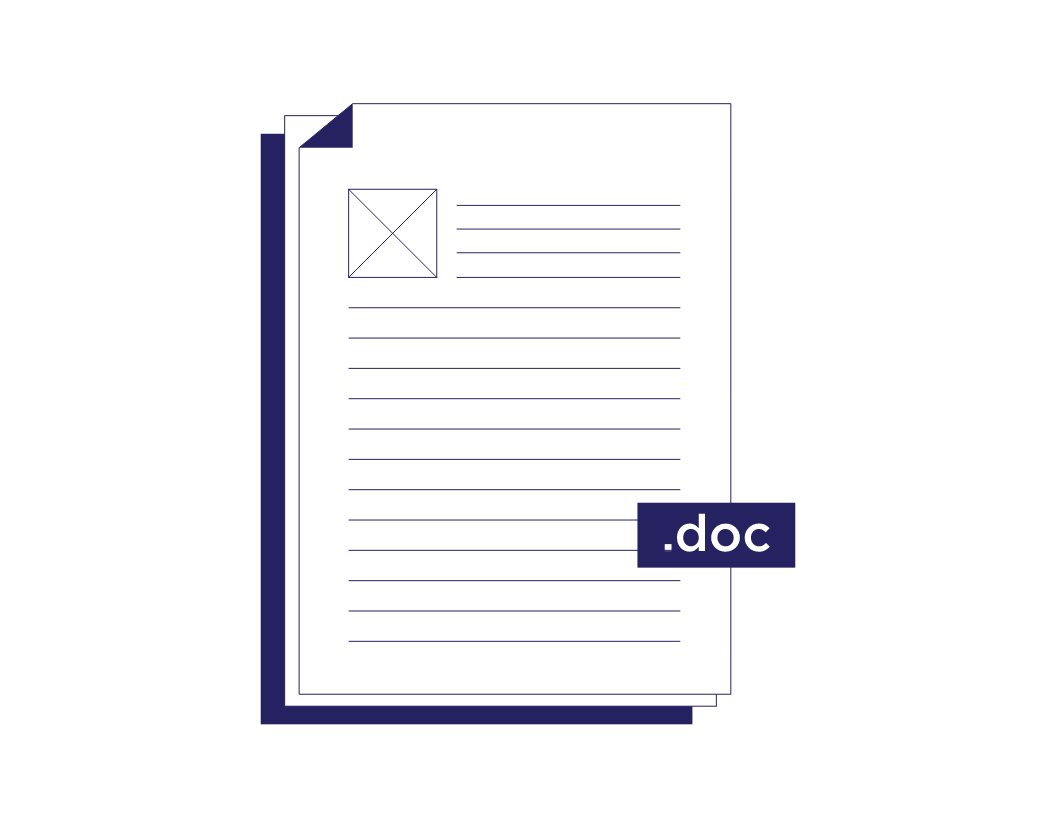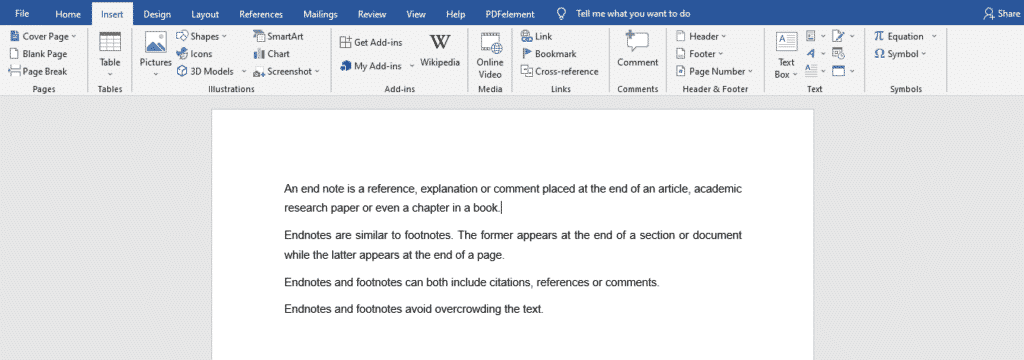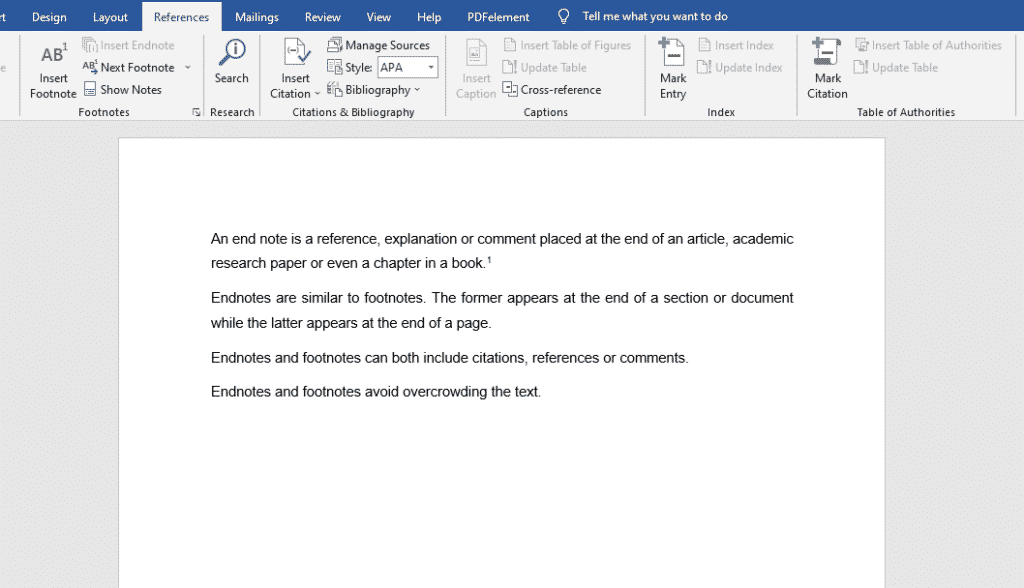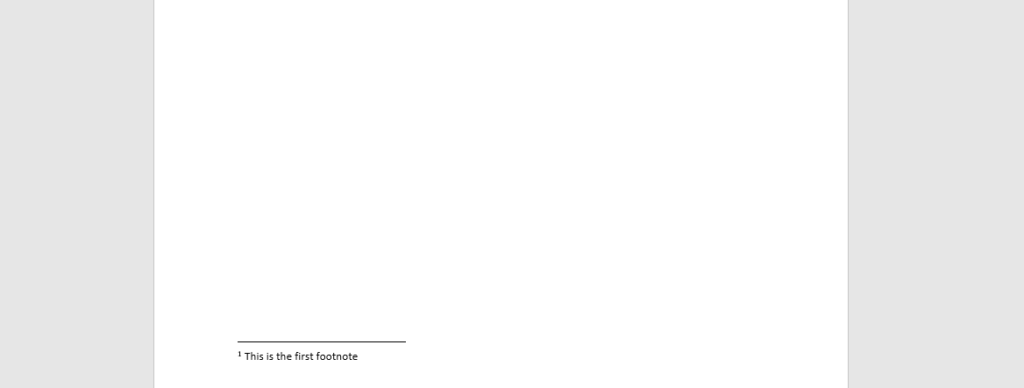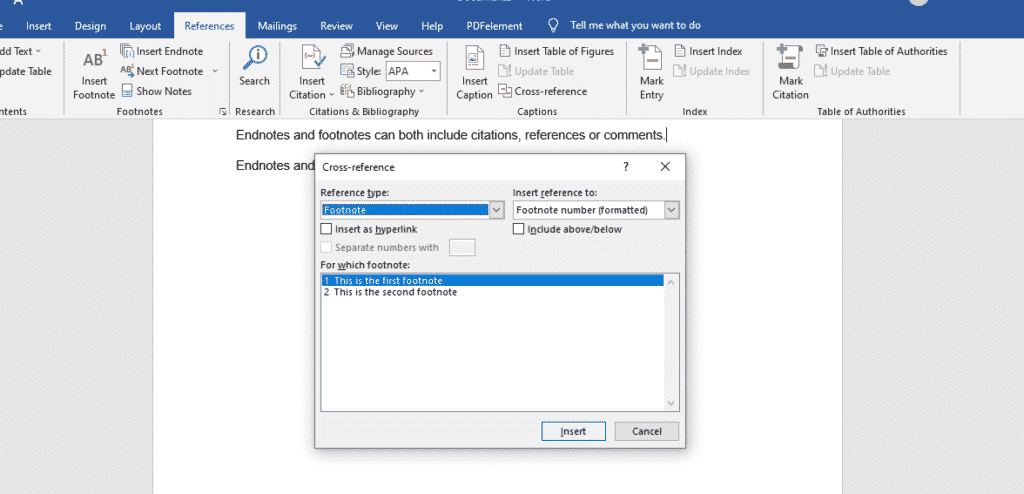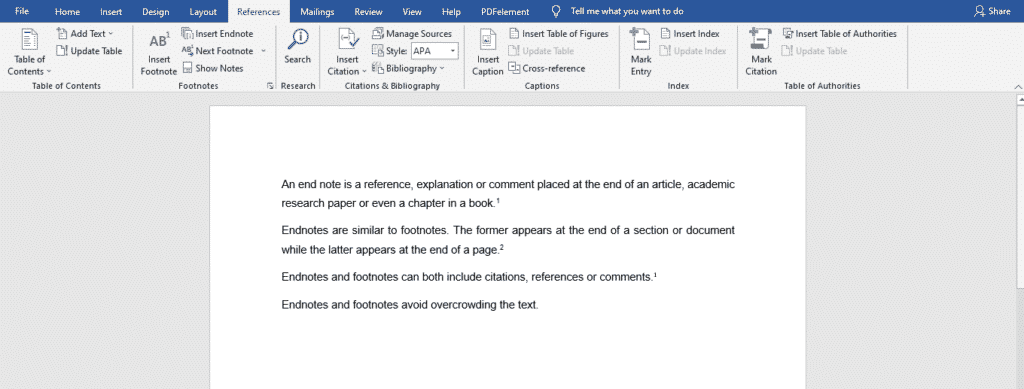Word for Microsoft 365 Word 2021 Word 2019 Word 2016 Word 2013 Word 2010 Word 2007 More…Less
A cross-reference allows you to link to other parts of the same document. For example, you might use a cross-reference to link to a chart or graphic that appears elsewhere in the document. The cross-reference appears as a link that takes the reader to the referenced item.
If you want to link to a separate document you can create a hyperlink.
Create the item you’re cross-referencing first
You can’t cross-reference something that doesn’t exist, so be sure to create the chart, heading, page number, etc., before you try to link to it. When you insert the cross-reference, you’ll see a dialog box that lists everything that’s available to link to. Here’s an example.
Insert the cross-reference
-
In the document, type the text that begins the cross-reference. For example, «See Figure 2 for an explanation of the upward trend.»
-
On the Insert tab, click Cross-reference.
-
In the Reference type box, click the drop-down list to pick what you want to link to. The list of what’s available depends on the type of item (heading, page number, etc.) you’re linking to.
-
In the Insert reference to box, click the information you want inserted in the document. Choices depend on what you chose in step 3.
-
In the For which box, click the specific item you want to refer to, such as «Insert the cross-reference.»
-
To allow users to jump to the referenced item, select the Insert as hyperlink check box.
-
If the Include above/below check box is available, check it to include specify the relative position of the referenced item.
-
Click Insert.
Cross-references are inserted as fields
Cross-references are inserted into your document as fields. A field is a set of information that instructs Word to insert text, graphics, page numbers, and other material into a document automatically. For example, the DATE field inserts the current date. The advantage of using fields is that the content being inserted—date, page number, graphics, etc.—gets updated for you whenever there’s a change. For example, if you’re writing a document over a period of days, the date will change each day when you open and save the document. Similarly, if you update a graphic that’s stored elsewhere but referenced in the field, the update will get picked up automatically without you having to re-insert the graphic.
If you’ve inserted a cross-reference and it looks similar to {REF _Ref249586 * MERGEFORMAT}, then Word is displaying field codes instead of field results. When you print the document or hide field codes, the field results replace the field codes. To see the field results instead of field codes, press ALT+F9, or right-click the field code, and then click Toggle Field Codes on the shortcut menu.
Use a master document
If you want to cross-reference items that reside in a separate document but don’t want to use hyperlinks, you’ll have to first combine the documents into one master document and then insert the cross-references. A master document is a container for a set of separate files (or subdocuments). You can use a master document to set up and manage a multi-part document, such as a book with several chapters.
Need more help?
Want more options?
Explore subscription benefits, browse training courses, learn how to secure your device, and more.
Communities help you ask and answer questions, give feedback, and hear from experts with rich knowledge.
A cross-reference in Word can refer to related information elsewhere in the same document (to refer to other documents, sources, etc., see how to use hyperlinks in Word). Cross-referencing helps the reader navigate a lengthy document and aids the author or reviewers to update the document structure by automating tracking changes in headings, picture or table numbers.
For example, you can write “see page 7,” or “in Chapter 3,” or “on Figure 3.” and the reader can click on the cross-reference link to view the information referred to by the author (works as hyperlinks). On the other hand (unlike hyperlinks), when editing a document, if its structure changes (for example, if the pagination changes or Chapter 3 becomes Chapter 4), cross-reference text is automatically updated.
Using a cross-reference, Word offers very helpful features to create and automatically update:
- a table of contents created from paragraphs formatted as headings or specified text fragments,
- an index created from defined index tags,
- a bibliography created from citations,
- footnotes and endnotes that are very useful to provide supporting information without interrupting the flow of the primary content,
- fields with the information from the document property.
Cross-references can be created for the following objects:
- Numbered item (if exist) – paragraphs and headings numbered using Word’s numbering,
- Heading formatted using one of Word’s built-in heading styles,
- Bookmark created using the Bookmark dialog box and marked a block of text,
- Footnote,
- Endnote,
- Equation created using the Microsoft Equation tool with a caption, created using Word’s Caption functionality,
- Figure (see how to insert figures in a Word document) with a caption, created using Word’s Caption functionality,
- Table (see how to create tables in a Word document) with a caption, created using Word’s Caption functionality.
- Other custom caption labels (for example, My Caption). See more about caption labels.
Traditionally, references for equations, tables, and figures are mentioned in a sentence before they appear in the document as near as possible. The first mention with a reference helps readers understand the relationship between equations, figures, and tables with the rest of the text.
If necessary, a new cross-reference can be added again to the already mentioned equation, figure, or table later in the text.
Insert a cross-reference
To insert a cross-reference, do the following:
1. Place the cursor where you want to insert the cross-reference.
2. Do one of the following:
- On the References tab, in the Captions group, click the Cross-reference button:
- On the Insert tab, in the Links group, click the Cross-reference button:
3. In the Cross-reference dialog box:
- In the Reference type list, select the type of reference that you want to link to:
- In the Insert reference to list, select the content type to display in the cross-reference.
The options in the Insert Reference to drop-down list change according to the Reference type list selection.
For example, for the Heading reference type:
See more about reference options for different reference types below.
- If the Insert as hyperlink box check box (selected by default) is:
- Selected, Word creates the hyperlink for the referenced item. So, the reader will be able to Ctrl+ click on it (or click on it – see how to change it) and go to the referenced item.
Note: Word doesn’t format this cross-reference as a hyperlink (blue and underlined).
- Not selected, Word creates a field without the possibility to jump to the source information.
- Selected, Word creates the hyperlink for the referenced item. So, the reader will be able to Ctrl+ click on it (or click on it – see how to change it) and go to the referenced item.
- If the Include above/below check box (not selected by default) is selected, Word will insert the word “above” or “below” in the cross-reference, depending on where the cross-reference is inserted, before or after the referenced item. This word will be changed along with the cross-reference itself if the referenced item is moved.
Note: This feature works for Numbered item and Heading. The above/below item is included in the Insert reference to list for other reference types.
For example, if the paragraph with Chapter 3 is moved after a paragraph with the cross-reference “see Chapter 3 above,” after updating fields in the document will be changed to “see Chapter 3 below.”
- In the For Which item list, select the needed item to reference.
For example, for Bookmark:
Note: In the For Which item list, Word shows all possible choices. If you can’t find the needed element in that list, check the formats and styles in the document content.
- Click the Insert button to insert the cross-reference in the document, then click the Close button to close the dialog box.
Note: You can move your cursor and insert additional cross-references while the Cross-reference dialog box is open.
Update references
Cross-references do not update automatically as other fields in Word. To update fields in the document, select the entire document by clicking Ctrl+A, or its part, and do one of the following:
- Press F9,
- Right-click on any of the fields and select Update Field in the popup menu:
So, your references will be automatically updated, and you can be sure that these references are correct. We strongly recommend checking a document at least visually after changes!
Delete references
To delete a reference, select it and press the Delete key.
Do not forget to update fields in the document!
Reference options
Cross-reference to Headings
Using the cross-referencing to the headings, you transfer to Word such routine as the automatic update of the headings whenever they are changed or moved.
To insert a cross-reference to the heading, in the Cross-reference dialog box:
- In the Reference type list, select the Heading.
- In the Insert reference to list, choose one of the proposed options:
- Heading text inserts the entire text of the Heading.
For example:
- Page number inserts the page number on which the Heading appears.
For example:
- Heading number inserts the Heading number that appears in a document if the heading is numbered, otherwise inserts 0.
For example:
- A heading contains numbering (see how to create the numbering for headings):
- Without numbering:
- A heading contains numbering (see how to create the numbering for headings):
- Heading number (no context) – the same as the previous one.
- Heading number (full context)
For example:
- Above/below inserts the word “above” or “below” in the cross-reference, depending on where the cross-reference is inserted, before or after the referred text. This word will be changed along with the cross-reference itself if the referred text is moved.
For example:
- Heading text inserts the entire text of the Heading.
It can be helpful to use several cross-references to the same heading:

Cross-referencing to Bookmarks
To insert a cross-reference to a bookmark, in the Cross-reference dialog box:
- In the Reference type list, select the Bookmark.
- In the Insert reference to list, choose any of the proposed options:
- Bookmark text inserts the entire text of the Bookmark.
For example:
- Page number inserts the page number on which the Bookmark appears.
For example:
- Paragraph number inserts the Paragraph number that appears in a document if the paragraph is numbered, otherwise inserts 0.
For example:
- Paragraph number (no context)
- Paragaraph number (full context)
- Above/below inserts the word “above” or “below” in the cross-reference, depending on where the cross-reference is inserted, before or after the referenced item. This word will be changed along with the cross-reference itself if the referenced item is moved.
- Bookmark text inserts the entire text of the Bookmark.
See how to work with bookmarks, automatically duplicate information in a Word document.
Cross-reference to Footnotes and Endnotes
Whenever you create footnotes (endnotes) in the document, you can use a single footnote (endnote) multiple times. To do this, for the second and subsequent use of the footnote (endnote) to the information already mentioned, link to the first footnote (endnote).
To insert a cross-reference to a footnote or endnote, in the Cross-reference dialog box:
- In the Reference type list, select the Footnote or Endnote.
- In the Insert reference to list, choose one of the proposed options:
- Footnote number or Endnote number inserts the footnote (endnote) number using the current formatting.
For example:
- Page number inserts the page number on which the footnote (endnote) appears.
For example:
- Above/below inserts the word “above” or “below” in the cross-reference, depending on where the cross-reference is inserted, before or after the referenced text.
This option is meaningless for footnotes and endnotes since all cross-references to an already created note must always be placed after it. This option can only help check the formatting, but do not forget to remove it for the document’s final version.
- Footnote number (formatted) or Endnote number (formatted) inserts the formatted footnote (endnote) number.
For example:
- Footnote number or Endnote number inserts the footnote (endnote) number using the current formatting.
Cross-reference to an Equation
When working with formulas, you can use two types of captions:
I. A caption was created using the Caption functionality (same as captions for tables and figures) with a number and description.
See Cross-reference to Figures and Tables to insert a cross-reference for such equations.
II. Just a number on the same line as equation right-justified:
See how to create a cross-reference for equations for more details.
Cross-reference to Equations, Figures, and Tables
Figures (pictures, images, icons, photos, etc.) and Tables in the document normally have the label Figure or Table and a number followed by a caption. A caption is a short block of text that provides quick information about the figure or explains table contents without referring to the document content.
To insert a cross-reference to the caption, created using the Caption functionality, in the Cross-reference dialog box:
- In the Reference type list, select the label such as Figure, Table.
- In the Insert reference to list, choose one of the proposed options:
- Entire caption inserts the caption with the label and number.
For example:
- Only label and number inserts the label (if exists) and the number.
For example:
- Only caption text inserts the figure caption or table title without the label and number.
For example:
- Page number inserts the page number on which the figure or table appears.
For example:
- Above/below inserts the word “above” or “below” in the cross-reference, depending on where the cross-reference is inserted, before or after the referenced item. This word will be changed along with the cross-reference itself if the referenced item is moved.
- Entire caption inserts the caption with the label and number.
About cross-referencing in Word – what is a cross-reference?
In this article, you will find general information about cross-referencing in Word. You will learn how cross-reference fields in Word work, how to insert a cross-reference, etc. The information applies to both cross-references you insert using Word’s own functionality and using the Word add-in DocTools CrossReferenceManager.
The DocTools CrossReferenceManager add-in makes it easier and faster to work with cross-references in Word than using the built-in functionality. However, cross-references you have inserted in a document using DocTools CrossReferenceManager work precisely as if they had been inserted using Word’s built-in functionality.
This article is relevant for Word 2010, Word 2013, Word 2016, Word 2019, and Word for Microsoft 365.
What is a cross-reference in Word?
In general, a cross-reference is a note in a text that tells you to look somewhere else in the text for more information.
In Word, you can insert dynamic cross-references that can be updated if the text you refer to changes.
Technically, a cross-reference in Word is a field, i.e. set of codes that instructs Word to automatically insert material into a document. The material inserted by cross-reference fields can be text, section numbers, paragraph numbers, caption numbers, caption labels, etc. The field code can also include special information (referred to as switches) that make the field act or look in a special way. For example, a cross-reference field may function as a hyperlink so you can jump directly to the target of the cross-reference by clicking the field.
As opposed to cross-references you type manually, the great advantage of using cross-reference fields is that you only need to update fields to have the cross-references corrected if you have made changes to the document.
Cross-reference example. This example has three cross-reference fields referring to the paragraph number, paragraph text, and page number of the target for the cross reference. In order to insert a cross-reference like the one in this example using Word’s own cross-reference feature, you have to insert three separate cross-references in three operations and type the surrounding text. The DocTools CrossReferenceManager add-in lets to do it all in one operation. The gray shading is the result of having field shading in Word turned on. It is visible on the screen only and does not print.
How to insert a cross-reference in Word?
Note that you can only insert cross-references to content that already exits in the document. For example, you cannot insert a cross-reference to a heading that has not yet been added to the document. In case you want to refer to something in another document, you can create a hyperlink.
The purpose of the article is not to go into detail about how to insert cross-references in Word but to explain how cross-references work. For completeness, here are the steps to follow to insert a cross-reference using the built-in functionality of Word:
- In your document, position the insertion point where the cross-reference is to be inserted.
- In the Ribbon, select References tab > Captions group: Cross-references.
Note that you will also find the command in Insert tab > Links group: Cross-references.The following takes place in the Cross-reference dialog box. See the illustration below.
- In the Reference type list, select the type you want.
You can select from: Numbered item, Heading, Bookmark, Footnote, Endnote plus caption types depending on which caption labels are available (e.g. Figure, Table, Equation). Note that the dialog box shows all types no matter whether there are any targets of the different types in your document.
- In the Insert reference to list, select what type of content you want the cross-reference to show.
The items in the list depend on what you selected as the reference type in step 3.
- Turn on Insert as hyperlink if you want the cross-reference field to function as a hyperlink so users can click or Ctrl-click it to jump to the target.
- In the For which list, select the item the cross-reference must refer to.
The list is empty if no items match the reference type you selected. - Click Insert.
The built-in Cross-reference dialog box that lets you insert cross-references in Word. The targets in the For which list depend on the reference type you have selected and of the content in your document.
When you have clicked Insert in the Cross-reference dialog box, a cross-reference field is inserted in your document. Note that you must update cross-references yourself if you make changes to the document that influence the cross-reference targets.
The procedure above includes the main steps needed for most cross-references. In the Cross-reference dialog box, the Separate numbers with and Include above/below check boxes are enabled under some conditions. They are used for special purposes and are not covered here.
If you want to insert cross-reference constructions like «See Section 1.2, «This is the title», page 14″, you will need to type the surrounding text and repeat the steps above three times because you need a cross-reference to three items: The paragraph number (1.2 in the example), the paragraph text («This is the title» in the example) and the page number (14 in the example). On the other hand, the DocTools CrossReferenceManager add-in lets you insert entire cross-reference constructions like «See Section 1.2, «This is the title», page 14″ in a single operation.
What to do if headings are missing in the Cross-reference dialog box?
In the illustration above, you can see that Heading is selected as the reference type in the Cross-reference dialog box. You can see that several headings are listed in the For which heading field.
If your document has a number of headings and if all or some of the headings are missing in the dialog box, you need to check the formatting of your document. All paragraphs that are formatted with one of the built-in styles Heading 1-9 are automatically shown in the dialog box. If you have used other styles for the headings, they will only appear in the heading list if the outline level of each of the headings has been set to one of the levels Level 1-9 in the Paragraph dialog box > Indents and Spacing tab > Outline level field. Headings with the outline level is set to Body Text will not appear in the target list.
Note that the style names of Heading 1, Heading 2, … , Heading 9 are language-specific. If your Word isn’t English, you will see another word than «Heading» but still with the numbers 1-9. For example, the styles are named Overskrift 1, Overskrift 2, etc. in Danish.
See also Shauna Kelly’s article Why use Microsoft Word’s built-in heading styles?
Are there different types of cross-reference fields?
Let’s look a bit closer into the cross-reference fields. When you insert a cross-reference, the field code inside the field will depend on what the reference refers to. There are three types of cross-reference fields in Word. The first part of the field code of a cross-reference field tells which type of field it is. The field type can be one of the following:
- REF
- PAGEREF
- NOTEREF
You can read more about the syntax later in this article.
Below, you can read about how the three types of cross-references work.
A cross-reference field that directly or relatively refers to the page on which the target is found is of the type PAGEREF. When you select “Page number” as the “Reference to insert” in the built-in Cross-reference dialog box in Word or in the Insert Cross-reference dialog box in DocTools CrossReferenceManager, the inserted cross-reference field will be of the type PAGEREF. Also, the custom text placeholders {P} and {P_a/b} that can be used in DocTools CrossReferenceManager will insert PAGEREF fields.
A cross-reference field with a footnote or an endnote as the target will be of the type NOTEREF.
All other cross-reference fields will be of the type REF.
How does a cross-reference field know which content to show?
In order for a cross-reference field to show the correct content, it must include information that makes this possible – and that is precisely what it does. The field code inside a cross-reference field refers to a bookmark that points out the target
A bookmark in Word is a named location or a named block of text or other content in a document.
The field code inside a cross-reference field includes a reference to a bookmark that acts as the target of the cross-reference. See the illustration below.
If you use the built-in functionality in Word for inserting e.g. a cross-reference to a heading, Word automatically adds a bookmark around the heading text, excluding the paragraph mark, if such bookmark is not already found. The name of the bookmark is included in the field code of the cross-reference field. Such automatically added bookmarks are named _Ref followed by eight or nine digits.
When inserting a cross-reference to a caption, a bookmark will also be used to enclose the part of the caption content that is to be displayed by the cross-reference field. The bookmark will enclose different parts of the caption depending on the kind of caption reference you select (e.g. the entire caption or only the label and number).
Example of cross-reference bookmark name
_Ref123456789
The underscore in start of the bookmark name results in the bookmark being handled as a hidden bookmark in Word. You cannot add hidden bookmarks manually, i.e. the built-in Bookmark dialog box doesn’t let you start a bookmark name with “_”.
Hidden bookmarks remain invisible on the screen even if you turn on display of bookmarks. In the Bookmarks dialog box, you must turn on Hidden bookmarks to have the hidden bookmarks listed in the dialog box.
The Bookmark dialog box showing bookmarks for cross-references (names start with _Ref) and table of contents (names start with _Toc).
You can see a list of bookmarks in a Word document in the Bookmark dialog box. To open the dialog box, select Insert tab in the Ribbon > Bookmark or press Ctrl+Shift+F5.
Note that names of bookmarks added by DocTools CrossReferenceManager follow the same syntax rules as the bookmarks added by the built-in cross-reference functionality.
Example of cross-reference field of the type REF showing the field result and the field code. In this example, the h switch is included which means that the field works as a hyperlink so that you go to the bookmarked target when clicking or Ctrl-clicking the field (depending on your Word settings).
The Bookmark dialog box showing the related _Ref bookmark.
What is the syntax of the field code in cross-reference fields of the types REF, PAGEREF and NOTEREF?
REF field code syntax
The syntax for REF fields is:
{ [REF] Bookmark [* Format Switch ] [Switches ] }
The format switch and switches parts are optional.
Examples:
PAGEREF field code syntax
The syntax for PAGEREF fields is:
{ PAGEREF Bookmark [* Format Switch ] [Switches ]}
The format switch and switches parts are optional.
Examples:
NOTEREF field code syntax
The syntax for NOTEREF fields is:
{ NOTEREF Bookmark [* Format Switch ] [Switches ]}
The format switch and switches parts are optional.
Examples:
How to format cross-references?
You may want cross-references in a Word document to stand out from the surrounding text. You can use switches to change the formatting of cross-references. As mentioned above, a «switch» in a Word field is special information that makes the field act or look in a special way.
Note that the DocTools CrossReferenceManager can automatically format cross-references. For example, you can automatically apply a style to cross-references you insert. For help on manually formatting cross-references, see Formatting Cross-references.
How to find information about the field switches?
As mentioned above, a «switch» in a Word field is special information that makes the field act or look in a special way.
In the general help on Word, you can find information about the different types of switches that can be used with specific fields.
The fastest way to find this information is often to search using your preferred browser. You can search for «field codes [TYPE OF FIELD] field» (example: «field codes ref field») or something similar. You will find a full list covering all field types in the Microsoft article List of field codes in Word.
Are cross-references updated automatically?
Note that cross-references do not update automatically. If cross-references refer to headings, bookmarks, numbers or other targets that have been changed, you need to update the fields to reflect the changes.
You can update cross-references manually by selecting all (Ctrl+A) and pressing F9. Cross-references will also be updated when you switch to Print Preview or when you print if the Word option File > Options > Display > Printing options: Update fields before printing is turned on.
For detailed information about how all types of fields are updated, see my article Updating Fields in Word – How it Works.
How to fix broken cross-references that do not show the correct content?
You may experience that one or more cross-reference fields in a document do not show the expected content even if you have updated fields.
For example, you may experience problems of the following types:
- A cross-reference is missing part of the text it should have shown
- A cross-reference to a numbered heading shows 0 instead of the expected number or shows a wrong number
- A cross-reference includes more text than expected
- A cross-reference shows an error, telling that the reference source is not found.
If you run into such problems, my article Cross-reference Problems – Troubleshooting on my website thedoctools.com can help you understand the cause of the problems and help you solve them. The article includes videos that illustrate what causes the problems and how to solve them.
Note that my add-in DocTools CrossReferenceManager can help you automatically find and fix cross-reference problems. It can even prevent some of the problems from occurring.
Generate complete documents in seconds from re-usable text or graphics
Manage comments in Word fast and easy – review comments, extract comments to Word or Excel, etc.
Simplify and speed up the management of cross-references even in your most complex documents
Manage and repeat data in Word fast and easy with custom document properties and DocProperty fields
Extract insertions, deletions and comments from any Word document, incl. context and headings
Apply any highlight color or remove highlight in Word with a single click – customizable shortcuts
Browse pages, sections, headings, tables, graphics, etc. and find text in Word with a single click
Check safety-critical procedure documents for human factor issues in minutes – improve quality and help prevent errors
Create screen tips in Word fast and easy – with up to 2040 characters
Understanding cross-referencing in Word and how cross-reference fields in Word work can save you from a lot of time and trouble with Word documents. I hope this article helps you in your future work with cross-references in Word.
In a recent tutorial, we looked at how to insert table titles and figure captions in Microsoft Word. Today, we’re going to use those titles and captions to cross-reference tables and figures in Microsoft Word.
One benefit of using cross-references in Word is that they can be hyperlinked to the connected table or figure.
In addition, Word’s cross-references can be easily updated if you add or delete a table or figure, as shown in the second section below.
This tutorial is also available as a YouTube video showing all the steps in real time.
Watch more than 200 videos about Microsoft Word and Adobe Acrobat on my YouTube channel.
The images shown here are from Word for Microsoft 365. These steps will also work for Word 2021, Word 2019, Word 2016, Word 2013, and Word 2010. However, your interface may look slightly different in those older versions of the software.
Important Note: These steps only work with existing tables and figures that have titles or captions created with Word’s caption tool.
- Place your cursor where you want to insert the cross-reference.
- Select the References tab in the ribbon.
- Select Cross-reference in the Captions group.
Pro Tip: The Cross-reference option is also available in the Insert tab.
- Select Figure or Table from the Reference type menu in the Cross-reference dialog box.
- Select an option from the Insert reference to menu:
-
- Entire caption (This option includes the figure caption or table title with the label and number.)
- Only label and number (e.g., Table 10)
- Only caption text (This option includes the figure caption or table title without the label and number.)
- Page number
- Above/below (This option inserts the word “above” or “below” with no additional text related to your table or figure.)
- Select Insert as hyperlink if you want to give your readers the ability to select the cross-reference and move to the table or figure.
- Select the table or figure you want to cross-reference from the For which caption menu.
- Select the Insert button.
Pro Tip: You can move your cursor and insert additional cross-references while the Cross-reference dialog box is open.
Your cross-reference will be inserted into your text immediately.
- Select the Close button to close the Cross-reference dialog box.
Cross-references don’t update automatically as you add or delete tables or figures. So, in the next section, we’ll look at how to update them simultaneously in just five steps.
How to Update Cross-References to Tables and Figures
If you need help updating table or figure numbers, please see “How to Update Table and Figure Numbers in Microsoft Word.”
- Select one of the cross-references in your text.
- Select the Home tab in the ribbon.
- Select Select in the Editing group.
- Select Select Text with Similar Formatting from the menu.
All your cross-references should now be selected.
- Right-click one of the cross-references and select Update Field from the shortcut menu.
Your cross-references should update immediately.
Pro Tip: If you don’t want to update all your cross-references, you can select an individual one, right-click, and then select Update Field from the shortcut menu, as shown in figure 15.
Related Resources
How to Insert and Modify Images in Microsoft Word
How to Reference Tables and Figures in Text
How to Write Table Titles
How to Write Figure Captions for Graphs, Charts, Photos, Drawings, and Maps
How to Create and Update a List of Tables or Figures in Microsoft Word
How to Add Heading Numbers to Table Titles and Figure Captions in Microsoft Word (PC & Mac)
Updated March 13, 2023
Insert a Cross-reference
- Click where you want to add a reference.
- Click the Insert tab.
- Expand the Links group, if necessary.
- Click the Cross-reference button.
- Select what you want the cross-reference to point to.
- Click the Insert reference to list arrow and select how you want the reference to be displayed.
Contents
- 1 How do you insert a Cross-reference in Word?
- 2 How do I automatically update cross-references in Word?
- 3 How do you cross-reference in an essay?
- 4 How do you check references and reference matches in Word?
- 5 How do I select all cross references in Word?
- 6 Why cross-reference does not update automatically?
- 7 How do I highlight all cross references in Word?
- 8 What is cross referencing example?
- 9 How do you use cross reference in a sentence?
- 10 What is cross reference in thesis?
- 11 How do you do a cross check reference?
- 12 How do I find missing references in Word?
- 13 Why is my cross referencing not working?
- 14 How do you change the cross-reference color in Word?
- 15 How do you highlight references in Word?
- 16 How do you cross-reference blue in Word?
- 17 Does cross reference have a hyphen?
- 18 What is cross-referencing in filing?
- 19 What is the purpose of cross-referencing?
How do you insert a Cross-reference in Word?
Creating cross-references in Word
- select the References tab.
- select Cross reference.
- choose the Reference type (Numbered item, Figure or Table)
- select the correct option in Insert reference.
How do I automatically update cross-references in Word?
To update all references in a document, select Edit – Select All (or press Ctrl A), then press F9 or right-click and select Update Field. You can set Word to always update cross-references before printing your document.
How do you cross-reference in an essay?
Now, a decent cross-reference consists of several elements: Name of the source being referenced—This can either be the title or a general subject reference. If it is a chapter title or a heading, put it in quotation marks; if it is the name of a book, magazine, report, or reference work, put it in italics or underline.
How do you check references and reference matches in Word?
To use this tool, go to the Main Menu on the left side in the Writing Center. Select the drop-down arrow next to Check to display the different Check Tools. From this list, select Match Reference Citations. Next you will see a message prompting you to run the Check tool.
How do I select all cross references in Word?
You can update cross-references manually by pressing Ctrl + A to select all and then pressing F9. Cross-references will also be updated when you switch to Print Preview or when you print (if the Word option Update fields before printing is turned on).
Why cross-reference does not update automatically?
This problem occurs because, when you create a cross-reference link, a hidden bookmark is created at the beginning of the heading. When you split the heading, the bookmark does not move. When you update the cross-reference link, the link is not updated.
How do I highlight all cross references in Word?
Press Ctrl-A to select all paragraphs. Press F9 to update all cross-references. (This will also update other fields in your document, such as the table of contents.)
What is cross referencing example?
To cross reference is defined as to discuss a detail that can be found in another location, often within the same book. An example of to cross reference is to mention a quote that can be found complete in another chapter.
How do you use cross reference in a sentence?
To a large extent this is simply a question of changing the cross-reference. This straightforward organisation makes it easy to look things up, cross-reference and navigate one’s way through the book. Users can also cross-reference how much they are being charged for medicines.
What is cross reference in thesis?
Cross reference is a reference to information located somewhere else in the same document. So if in Chapter 3 of a book, the reader is referred to Appendix A for more detailed information on a specific topic, that’s a cross reference.
How do you do a cross check reference?
One traditional way to cross-check references is to print out the reference list and then scan through all of the references in the dissertation text to make sure that you properly cited your sources (e.g., author spelling and year match in both locations).
How do I find missing references in Word?
On the Tools menu, click References to display the References dialog box. You see that Refme. dot is marked as “missing”. Click Cancel to close the References dialog box.
Why is my cross referencing not working?
The fix is: Close all instances of Word that are running, including other non-problem Word documents. Open up the problem Word document, but before clicking on the references, make sure this document is located in another monitor, not the same monitor you just used.
How do you change the cross-reference color in Word?
using the drop-down button in the “Styles” group of the ribbon, choose “Apply styles…” in the “Apply Styles” dialog box under “Style Name” choose the name of the style you want to change (e.g. “intense reference”) Click the “Modify…” button. Change the formatting to suit you and click “OK”
How do you highlight references in Word?
You can change the settings for highlighting Fields/Reference Marks in your word processor:
- Word for Windows: In Word Options, open “Advanced”, then set “Field shading” to “Never”, “Always”, or “When selected”.
- Word for Mac: Open Word → Preferences → View and set “Field shading” to “Never”, “Always”, or “When selected”.
How do you cross-reference blue in Word?
If you really want to have the cross-references look like hyperlinks:
- Press Alt-F9 to expose the document’s field codes.
- Edit each cross-reference field code so it looks like { REF BkMk * Charformat h }
- Format the ‘R’ in ‘REF’ blue, with underlining;
Does cross reference have a hyphen?
Do not use a hyphen in chemical terms.Hyphenate words prefixed by ex-, self-, or all-, and some words prefixed by cross-. Examples: ex-wife; self-evident; all-inclusive; cross-reference. NOTE: Cross section (the noun) is two words, but cross-sectional (the adjective) is hyphenated.
What is cross-referencing in filing?
A cross reference is a tool for finding a record by reference to a name or subject other than the one the document was filed under. A. When to Use Cross References. When a document contains more than one important subject, it should be filed under the most important one and cross references made for the other subjects.
What is the purpose of cross-referencing?
Cross-referencing is a powerful tool that can greatly enhance the usefulness of your work, allowing readers to link quickly and easily from one part of your work to related material elsewhere, making your work significantly more functional and useful.
Insert and Manage Dynamic Cross-Reference Fields in Microsoft Word
by Avantix Learning Team | Updated October 9, 2021
Applies to: Microsoft® Word® 2010, 2013, 2016, 2019 or 365 (Windows)
In Microsoft Word, you can insert a cross-reference to content in another part of your Word document and then update it if the target of the cross-reference changes. A cross-reference can refer to a heading, bookmark, the caption of a table or figure as well as other target items. Since a cross-reference is a field, it can be updated and formatted manually, using styles or using switches in the field.
Recommended article: How to Keep Text Together in Microsoft Word (Paragraphs, Lines or Words)
The information inserted by a cross-reference field can be text, a page number, a section number, a paragraph number, a caption number, a caption label or a combination of items. The cross-reference field is a code so it can also include special information in the code (called a switch) that make the field act or appear in a specific way. For example, a cross-reference field may act as a hyperlink so you can jump directly to the target of the cross-reference by Ctrl-clicking the field.
It’s easiest to create cross-references to built-in heading styles but they can also be used with bookmarks, footnotes or endnotes.
For example, you could insert a cross-reference to a built-in heading style as follows:
See Section 4: About Our Services on page 5.
In this case, the cross-reference refers to a style’s paragraph number, paragraph text and a page number so you would need to insert three separate cross-references and type some of the text (like the word See) as well as appropriate spacing.
Inserting a cross-reference to a built-in heading
It’s common to create a cross-reference to a built-in heading in Microsoft Word.
To insert a cross-reference to a built-in heading in the current document:
- Position the cursor where you want to insert your cross-reference.
- Type text that you want to precede the cross-reference (such as See) and any necessary spacing.
- Click the References tab in the Ribbon.
- In the Captions group, click Cross-reference. A dialog box appears.
- In the Reference type drop-down menu, select Heading.
- In the Reference to drop-down menu, select Heading text, Page number, Heading number, Heading number (no content) or Heading number (full content).
- In the For which heading list, click the item you want to reference.
- Ensure Insert as hyperlink is selected If you want to be able to Ctrl-click the cross-reference to jump to the referenced item.
- Click Insert. Word inserts an invisible bookmark to the target.
- Repeat for other items you want to include in the cross-reference. The dialog box can remain open.
- Click Close.
In the following example, note that Heading has been selected as the Reference type in the Cross-reference dialog box:
In the Cross-reference dialog box, the Separate numbers with and Include above/below check boxes are enabled under some conditions.
All paragraphs that are formatted with one of the built-in heading styles (Heading 1-9) are automatically shown in the dialog box. Although you can use outline levels, it’s best to use the built-in heading styles (these appear in the Home tab in the Ribbon in the Styles group and in other areas in Word).
Inserting a cross-reference to a bookmark
You can also insert a bookmark and then insert a cross-reference to the bookmark.
To insert a cross-reference to a bookmark in the current document:
- Position the cursor where you want to insert a bookmark.
- Click the Insert tab in the Ribbon.
- Click Bookmark in the Links group. A dialog box appears.
- Type a name for the bookmark without spaces.
- Click Add.
- Click where you want to insert the cross-reference to the bookmark.
- Type text that you want to precede the cross-reference (such as See) and any necessary spacing.
- Click the References tab in the Ribbon.
- In the Captions group, click Cross-reference. A dialog box appears.
- In the Reference type drop-down menu, select Bookmark.
- In the Reference to drop-down menu, select Bookmark text, Page number or one of the other options as required.
- In the For which heading list, click the item you want to reference.
- Ensure Insert as hyperlink is selected If you want to be able to Ctrl-click the cross-reference to jump to the referenced item.
- Click Insert.
- Repeat for other items you want to include in the cross-reference. The dialog box can remain open.
- Click Close.
The following is an example of a bookmark created in the Bookmark dialog box:
Inserting a cross-reference to a table or figure
You can cross-reference tables and figures in Word if you have inserted captions using Insert Caption on the References tab in the Ribbon.
To insert a cross-reference to a table or figure in the current document:
- Click where you want to insert the cross-reference to the table or figure (which has already been captioned).
- Type text that you want to precede the cross-reference (such as See) and any necessary spacing.
- Click the References tab in the Ribbon.
- In the Captions group, click Cross-reference. A dialog box appears.
- In the Reference type drop-down menu, select Table or Figure.
- In the Reference to drop-down menu, select the required option – Entire caption (which includes the figure caption or table title with the label and number), Only label and number (such as Table 10), Only caption text (which includes the figure caption or table title without the label and number), Page number or Above/below (which inserts the word above or below with no additional text related to the table or figure).
- In the For which heading list, click the table or figure you want to reference.
- Ensure Insert as hyperlink is selected If you want to be able to Ctrl-click the cross-reference to jump to the referenced item.
- Click Insert.
- Repeat for other items you want to include in the cross-reference. The dialog box can remain open.
- Click Close.
In the following example, note that Table has been selected as the Reference type in the Cross-reference dialog box:
Showing or hiding field codes
Cross-references are fields. Normally, the result of a field is displayed but you can also view the field codes.
To show or hide all field codes in your document, press Alt + F9.
The following is an example of a field code:
{ REF _Ref46507086 h }
Understanding cross-reference field codes
When you insert a cross-reference, a field code will be inserted based on what the reference refers to.
There are three types of cross-reference fields in Word – PAGEREF, NOTEREF and REF. The first part of the field code of a cross-reference field indicates which type of field it is.
A cross-reference field that refers to the page on which the target is found is a PAGEREF type. When you select Page number as the Reference to insert in the Cross-reference dialog box, the inserted cross-reference field will be PAGEREF.
A cross-reference field with a footnote or an endnote as the target will be the NOTEREF type.
All other cross-reference fields will be the REF type.
Part of the field code inside a cross-reference field refers to a bookmark that points to the target. A bookmark in Word is a named location or a named block of text or other content in a document.
If you refer to a built-in heading style in a cross-reference, Word automatically adds a bookmark around the heading text at the beginning and the end (excluding the paragraph mark) if a bookmark is not already found. The name of the bookmark is included in the field code of the cross-reference field. Bookmarks that are automatically added are named _Ref followed by eight or nine digits.
If you are inserting a cross-reference to a caption, a bookmark will also be added to enclose the part of the caption content to be displayed by the cross-reference field. The bookmark will include different parts of the caption depending on the kind of caption reference you select (such as the entire caption or only the label and number).
The following is an example of a cross-reference for a REF field:
{ REF _Ref449977221 p h d».»* CHARFORMAT }
The syntax for REF fields is:
{ REF Bookmark [* Format Switch ] [Switches ] }
Switches are optional.
The underscore at the start of the bookmark name means that the bookmark is being treated as a hidden bookmark in Word. You cannot add hidden bookmarks manually.
Hidden bookmarks are invisible in the document even if you turn on display of bookmarks. You can view invisible bookmarks in the Bookmarks dialog box, but you must turn on Hidden bookmarks to display them.
Formatting cross-references
Cross-references can be formatted manually, using styles or using switches in the field code. A switch holds special information that causes the field to act or appear in a specific way.
One easy way to format a cross-reference is by using a character style such as Emphasis or Intense Emphasis.
To apply the Emphasis, Intense Emphasis or Intense Reference character style to a cross-reference:
- Select the cross-reference as well as any surrounding text that refers to it.
- Click the Home tab in the Ribbon.
- Click the More down arrow in the Style gallery in the Styles group.
- Click Emphasis, Intense Emphasis or Intense Reference.
The benefit of this method is that you can later modify the style or find and replace the style with a different style.
In a future article, we’ll take a look at more advanced formatting techniques for cross-references.
Updating cross-references
If a document has been edited, you will likely need to update the cross-references since cross-references do not update automatically.
It is important that the markers that are added at the beginning and end of the target of a cross-reference are not deleted or moved during editing. If they are, you will need to reinsert the cross-reference because you will receive an error when you update.
You can update cross-references manually by pressing Ctrl + A to select all and then pressing F9.
Cross-references will also be updated when you switch to Print Preview or when you print (if the Word option Update fields before printing is turned on).
To ensure that fields are updated before printing:
- Click the File tab in the Ribbon.
- Click Options.
- Select Display in the categories on the left.
- In Printing options, select Update fields before printing.
- Click OK.
Be sure to check after update to see if there are any errors in your cross-references.
Subscribe to get more articles like this one
Did you find this article helpful? If you would like to receive new articles, join our email list.
More resources
14 Timesaving Microsoft Word Selection Shortcuts
How to Update All Figure Numbers in Microsoft Word
How to Insert the Not Equal Sign in Word (5 Ways to Type or Insert ≠)
How to Keep Text Together in Microsoft Word (Paragraphs, Lines or Words)
How to Create a Table of Contents in Word (Insert, Format and Update a TOC)
Related courses
Microsoft Word: Intermediate / Advanced
Microsoft Excel: Intermediate / Advanced
Microsoft PowerPoint: Intermediate / Advanced
Microsoft Word: Long Documents Master Class
Microsoft Word: Styles, Templates and Tables of Contents
Microsoft Word: Designing Dynamic Word Documents Using Fields
VIEW MORE COURSES >
Our instructor-led courses are delivered in virtual classroom format or at our downtown Toronto location at 18 King Street East, Suite 1400, Toronto, Ontario, Canada (some in-person classroom courses may also be delivered at an alternate downtown Toronto location). Contact us at info@avantixlearning.ca if you’d like to arrange custom instructor-led virtual classroom or onsite training on a date that’s convenient for you.
Copyright 2023 Avantix® Learning
Microsoft, the Microsoft logo, Microsoft Office and related Microsoft applications and logos are registered trademarks of Microsoft Corporation in Canada, US and other countries. All other trademarks are the property of the registered owners.
Avantix Learning |18 King Street East, Suite 1400, Toronto, Ontario, Canada M5C 1C4 | Contact us at info@avantixlearning.ca
Cross-references refer readers to other parts of your document. In Microsoft Word, you can also use them to link to headings, bookmarks, tables, figures, and footnotes. This can help readers to find important details in your writing. Here, then, is a quick guide on how to cross-reference in Microsoft Word.
Getting Started with Cross-References in Word
The first step in cross-referencing parts of a document in Microsoft Word is making sure you have something to cross-reference (e.g., headings, figures, tables). As you are drafting your document, then, think about what you might need to link.
Once you have created the items you want to cross-reference, though, you can:
- Select where you want to add a cross-reference and, if necessary, add introductory text (i.e., a sentence or additional text that you want to precede the page number, heading text, or other item that you’ll be using as a cross-reference).
- Open the cross-reference tool by going to the Insert or References tab at the top of your screen and clicking on Cross-reference.
This will open a menu where you can select a reference type (i.e., the document element you want to cross-reference, such as a heading, figure, or chart) and the type of text you want to use as a cross-reference (e.g., a page or paragraph number).
We’ll look at the options available here for creating cross-references below.
Cross-Referencing Options
First, select the latter via the Reference type dropdown menu, where the options are:
- Numbered item – Create a cross-reference to text formatted as a numbered list (either an item from a list or a numbered heading).
- Heading – Create a cross-reference to text that uses a Heading style.
- Bookmark – Cross-reference text that has been bookmarked.
- Footnote/Endnote – Select a footnote or endnote to cross-reference.
- Equation/Figure/Table – Select an equation, figure, or table from the document (based on the label applied to the accompanying caption).
The Insert reference to dropdown menu on the right-hand side of the dialogue box, meanwhile, lets you decide what kind of reference you will add.
For example, in the image below, we have selected Page number. This would add the page number of the selected heading in the place selected. If we selected Above/below, on the other hand, it would add the word above or below depending on where the reference is in relation to the item being referenced.
The options in this menu will depend on the cross-reference type (e.g., if you cross-reference a footnote or endnote, you will be able to select the note number here, whereas this isn’t available for other types of cross-references). But all you need to do is select the option most relevant to where you are adding it (e.g., if your cross-reference starts with See page…, you’ll want to add a page number).
Find this useful?
Subscribe to our newsletter and get writing tips from our editors straight to your inbox.
You can also select whether to make the cross-reference a hyperlink here (this is often selected by default). Doing this means that readers can click the cross-reference text to navigate to the part of the document being referenced, which can be very useful in online copy or electronic documents.
How to Insert a Cross-Reference in Microsoft Word
Let’s look at how to create a cross-reference for a heading in practice:
- Place the cursor where you want to add a cross-reference (e.g., immediately after any introductory text, or in a header for running chapter headers).
- Open the cross-referencing tool as described above.
- Select Heading from the Reference type dropdown menu.
- Under Insert reference to, select what to add as a cross-reference. For our example, we have selected Page number, which will add the page number for the heading we select.
- Decide whether to check the Insert as hyperlink box to make the cross-reference a link to the referenced part of the document.
- Click Insert to add the cross-reference to the document.
We have now added the page number for the heading in the place selected. And clicking the hyperlinked text here would take us straight to the heading.
The other cross-reference types (numbered item, bookmark, footnote, etc.) follow the same basic format as the heading reference type, as shown above. All you need to do is adapt the process to match the reference type you want to use.
Updating Cross-References in Microsoft Word
One major advantage of using the cross-reference tool in Microsoft Word, as opposed to typing out cross-references manually, is that you can update them at the click of a button. To do this:
- Right click the text that you added with the cross-reference tool.
- Select Update Field from the contextual menu (see below).
Doing this will automatically update the cross-reference text to match any changes made to the source text. For instance, if you added a cross-reference based on the text of a heading somewhere in the document, but then changed the heading after adding the cross-reference, right-clicking and selecting “Update Field” would update the cross-reference to use the revised heading text. Or if the page numbering changed after adding a cross-reference based on a page number, updating it would change the cross-reference to reflect the new pagination.
You can also update multiple cross-references at the same time by selecting all the relevant text. However, this will also update any other fields selected (e.g., a table of contents or list of figures). As such, make sure you only select the fields you want to update if you are updating multiple cross-references in one go.
Professional Proofreading Services
Using cross-references in Microsoft Word can help readers to get the most out of your document. If you would like any extra help to ensure your writing is clear and error-free, though, why not try our proofreading services today?
To assist your readers in quickly moving to pertinent information in your document, you can use the Cross-Reference feature in Microsoft Word. This allows your audience to simply click and navigate to related information in the same document.
Unlike the Insert Link feature in Word that allows you to link to other places in your document, the Cross-Reference feature works with tables, figures, footnotes, endnotes, and numbered items rather than just headings and bookmarks.
Set a Cross-Reference to a Table or Other Object in Word
You may have a document where you want to reference a section with a header, a figure on another page, or a footnote containing extra details. Be sure that you have the items you want to reference already in place so that they display in the Cross-Reference setup window.
RELATED: How to Insert a Section Break in Microsoft Word
To create the cross-reference, move your cursor to the spot in your document where you’d like to insert it. Do not select existing text to serve as the link because you’ll pick the information you want to use during the following process.
Go to the Insert tab, click the Links drop-down arrow, and choose “Cross-Reference.”
When the Cross-Reference window appears, choose the Reference Type from the drop-down list. You’ll see that you can choose a numbered item, heading, bookmark, footnote, endnote, equation, figure, or table. For this example, we’ll use a table.
After you select the Reference Type, you’ll see those items in your document display in the For Which box at the bottom of the window. If nothing appears in the box, then you do not have that Reference Type within your document.
Next, choose what the link will appear as using the Insert Reference To drop-down box. The options available here depend on the Reference Type you select. For example, you can select the entire caption for a table, the label and number for an equation, or the heading text for a heading.
Check the box for Insert as Hyperlink if it’s not already marked. Then, click “Insert” to add the cross-reference.
You should see the Insert Reference To item you choose pop into the text in your cursor’s spot. In the example below, this displays as Table A since we selected a Table as the Reference Type and
“Entire Caption” as the Insert Reference To item.
When you click (or hold Ctrl and click) the linked text, you should jump directly to the referenced item.
Create a Cross-Reference to a Page Number
Let’s look at one more example using a different cross-reference setup. We’ve created a numbered list of instructions and want to cross-reference one of the steps using a page number in our text.
RELATED: How to Create a Numbered List in Word Using the Keyboard
Place the cursor where you want the reference, click the Links drop-down box on the Insert tab, and select “Cross-Reference” as before.
For Reference Type, pick “Numbered List” and you’ll see each list item in the For Which box. Select the list item you want to use. For Insert Reference To, choose “Page Number.” Click “Insert.”
You’ll see the number “2” was placed in our text where the cursor was because our numbered list is on page two.
When you click (or hold Ctrl and click) the linked number 2, it takes you directly to the step selected on page two.
If you’re creating a document full of equations, figures, tables, or other items that you want to make easier for your audience to find, consider the Cross-Reference feature in Microsoft Word. And if you want to create links to other documents from your current one, learn more about the Insert Link feature in Word.
READ NEXT
- › How to Create Your Own Bibliography Template in Microsoft Word
- › Universal Audio Volt 2 Review: A Workhorse Audio Interface With Vintage Charm
- › Why One Ultrawide Is Better Than Two Monitors
- › Why the Right-Click Menu in Windows 11 Is Actually Good
- › The Best DNS Servers for Secure Browsing
- › Google+ Will Come to a Final End on July 5, 2023
- › Get to Your Windows 11 Desktop: 7 Fastest Methods
Cross-referencing is defined as discussing a detail found in another location, often within the same book, paper, or article.
To cross-reference, you may use an endnote or a footnote to refer to more than one part of a text containing related information.
For example, if you discuss the need to switch to environmentally friendly packaging in three different parts of a text, it is unnecessary to have three separate endnotes or footnotes. You can use one and ‘cross-reference it’ in the other two locations.
This article will guide you on how to cross-reference in Word.
Open the document where you would like to cross-reference
The first step is adding the footnote(s) or endnote(s)
First, go to the section of the text where you would like to add the footnote or endnote. Leave the clicker at the end of a sentence or a paragraph.
Go to the references tab at the top of your screen and select the large ‘Insert Footnote’ icon.
Two superscript numbers will appear when you do this, one besides the text area where you want to note your source and a corresponding one at the bottom of the page. This number will guide the reader on which footnote belongs to which text.
At the bottom of the text, you can start typing out your footnote.
For endnotes, in the references tab, click ‘Insert Endnote.’
The same superscript numbers will appear, and you can type out your endnote under the long horizontal line that appears.
Now let us get to cross-referencing.
- After inserting two or three more endnotes/ footnotes, go to the part of your text where you would like to insert a footnote/ endnote you have already used.
- Instead of going to the references tab, go to ‘insert.’
In the sixth column, select ‘cross-reference.’
A pop-up box will appear.
- Reference type
Here, select the kind of reference you would like to have. Choose either the endnote or footnote.
- Insert as hyperlink
Check this box
- Insert reference to
In step 3, if you selected a footnote, then choose the footnote number (formatted). If you picked an endnote, then the corresponding choice is the endnote number (formatted).
- To which reference
Earlier, we added two or three more endnotes/footnotes.
They will appear under a box with ‘to which reference.’
Select the already existing footnote/endnote that contains related information to the text you want to cross-reference.
When you are done checking all the necessary boxes, click insert,
The same superscript number corresponding to the already existing footnote/endnote will appear next to the text that you have cross-referenced.
You can repeat this for as many parts of a text as you want.
Online learning has become the norm since the novel coronavirus spread to the rest of the world in 2020.
Countries moved from one phase of the mandatory lockdown to the next. It has become crucial to find tools to enable academic institutions to continue functioning as best as they can.
Simul Docs is one such tool. With Simul Docs, students can collaborate on written assignments from different locations simultaneously.
All you have to do is write the first sample in Microsoft Word and upload it to Simul.
Simul will automatically make this the first version.
Your other project partner can now open this version and make their changes and additions, creating another version of the same document.
While you are making your edits, you can also add comments for your group mates for example pointers, books you used or further instructions.
After everyone has made their submissions and changes, you can merge the edited versions to create one complete document.
This document shows tracked changes in Word so everyone can see where edits were made and if they should be rejected or approved. Simul recognises that sometimes you might forget to turn on tracked changes while editing, so these modifications are automatically updated regardless of your online or offline status.
Additionally, you can make these changes simultaneously; this is not a one-login at a time situation.
Even if another colleague wants to make changes but does not have Simul, the document can still be downloaded, emailed, or even uploaded to any cloud storage software like OneDrive. Once they are done with their edits, they can email it back to you, and you can add it to Simul once again, which will create a different version.
Download simuldocs.com today and make frustrating group projects a thing of the past.

